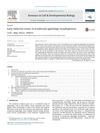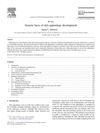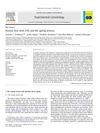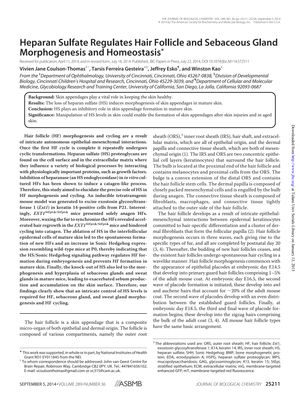TLDR Heparan sulfate is important for hair growth, preventing new hair formation in mature skin, and controlling oil gland development.
The study investigated the role of Heparan sulfate (HS) in hair follicle (HF) morphogenesis, cycling, and sebaceous gland function using an inducible tetratransgenic mouse model that lacked the enzyme exostosin glycosyltransferase 1 (Ext1) in keratin 14-positive cells from postnatal day 21 (P21). The results showed that mice with the Ext1 deletion (EXT1^StEpiΔ/StEpiΔ) maintained their hair follicles in the growth phase (anagen) and experienced accelerated hair regrowth after waxing, suggesting that HS is involved in the transition to the regression phase (catagen). Additionally, the absence of HS in mature skin led to the spontaneous formation of new hair follicles and increased Sonic Hedgehog expression, which is similar to the process during embryogenesis, indicating that HS normally prevents new HF formation in mature skin. The study also found that HS deficiency caused morphogenesis and hyperplasia of sebaceous and sweat glands, resulting in increased sebum production. These findings demonstrate that HS is crucial for regulating hair follicle development, hair growth cycles, and sebaceous gland homeostasis.
 160 citations
,
January 2014 in “Seminars in cell & developmental biology”
160 citations
,
January 2014 in “Seminars in cell & developmental biology” Early development of hair, teeth, and glands involves specific signaling pathways and cellular interactions.
 300 citations
,
August 2012 in “Seminars in Cell & Developmental Biology”
300 citations
,
August 2012 in “Seminars in Cell & Developmental Biology” The conclusion is that certain cell interactions and signals are crucial for hair growth and regeneration.
161 citations
,
August 2012 in “Seminars in cell & developmental biology” Hair growth and development are controlled by specific signaling pathways.
 138 citations
,
June 2012 in “Genes & Development”
138 citations
,
June 2012 in “Genes & Development” Sonic hedgehog signaling is crucial for hair growth and maintaining hair follicle identity.
321 citations
,
January 2012 in “Cell stem cell” TGF-β2 helps activate hair follicle stem cells by counteracting BMP signals.
117 citations
,
April 2008 in “Developmental biology” Ectodysplasin inhibits Wnt signaling to help form hair follicles.
22 citations
,
March 2007 in “European journal of pediatrics” Certain types of mucopolysaccharidoses cause significant hair abnormalities.
 111 citations
,
January 2007 in “Seminars in cell & developmental biology”
111 citations
,
January 2007 in “Seminars in cell & developmental biology” Hair, teeth, and mammary glands develop similarly at first but use different genes later.
 1113 citations
,
August 1999 in “The New England Journal of Medicine”
1113 citations
,
August 1999 in “The New England Journal of Medicine” Hair follicle biology advancements may lead to better hair growth disorder treatments.
 3 citations
,
December 2022 in “npj Regenerative Medicine”
3 citations
,
December 2022 in “npj Regenerative Medicine” HSPGs help control stem cell behavior, affecting hair growth and offering a target for hair loss treatments.
 5 citations
,
November 2022 in “Animal Genetics”
5 citations
,
November 2022 in “Animal Genetics” Genomic research can help improve the quality and production of natural fibers in animals.
22 citations
,
July 2016 in “Cellular and Molecular Life Sciences” Genetic changes in mice help understand skin and hair disorders, aiding treatment development for acne and hair loss.
 143 citations
,
September 2008 in “Experimental gerontology”
143 citations
,
September 2008 in “Experimental gerontology” Skin aging is due to impaired stem cell mobilization or fewer responsive stem cells.
 3 citations
,
November 2018 in “Curēus”
3 citations
,
November 2018 in “Curēus” The cause and importance of misplaced oil glands in the hair follicle are not well understood.









